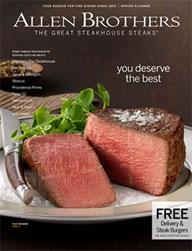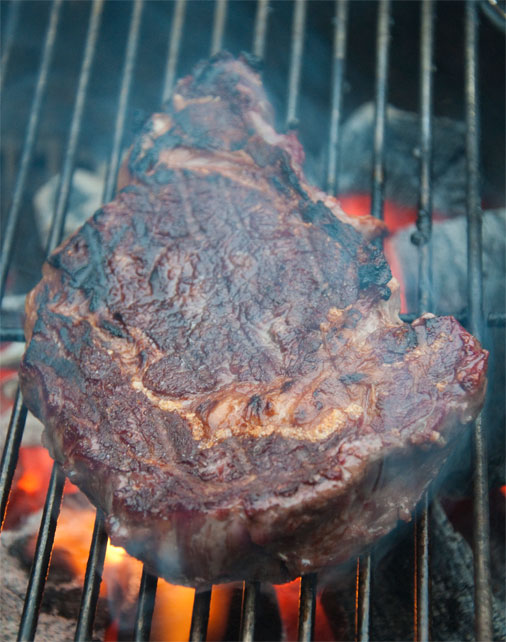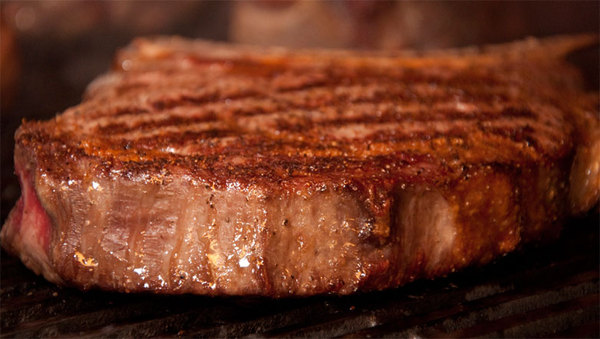
You can read more reports from Meathead's grill deck at AmazingRibs.com
"The secret of a great meal ain't what's on the table. It's what's on the chairs." Meathead
Steaks are easy. Hard to mess up. Unless you overcook them. But you use a good digital instant read thermometer so you never ruin expensive steaks, don't you? Regardless of what cut of steak you cook, there are some basic tips and techniques that can raise your game, and when you master them, you will have your guests reeling in deliria.
The cuts
The grades
(1) Your comments are off-topic
(2) They are intended to provoke.
Notice I refer to the best steakhouses as prime steakhouses. Prime is the top grade of meat and you won't find it in discount steakhouses in mall parking lots or in your grocery. Prime beef is selected because it has a lot of marbling, thin hairline grains of fat that weave weblike through the fibers of protein. You can see it. Most of it goes to restaurants.
Some steakhouses also serve aged meat, another commodity that is not readily available to we peons. For more about prime meat and the other grades of beef that a good backyard cook needs to know, read my article on The Zen of Beef Grades & Labels.
 You can get prime meat, and aged meat, for cooking at home, just like restaurants. But you have to look for it. Only specialty butchers have it. If you can't find it in stores, order it online. I'm a fan of the meats sold by Allen Brothers in Chicago. I've toured their plant and it is very very impressive. The suppliers are top notch, the meat is fresh, beautiful, it is stored properly, the plant is highly organized and clean, and the trimmers are very skilled. Their packing and shipping operation is impressive.
You can get prime meat, and aged meat, for cooking at home, just like restaurants. But you have to look for it. Only specialty butchers have it. If you can't find it in stores, order it online. I'm a fan of the meats sold by Allen Brothers in Chicago. I've toured their plant and it is very very impressive. The suppliers are top notch, the meat is fresh, beautiful, it is stored properly, the plant is highly organized and clean, and the trimmers are very skilled. Their packing and shipping operation is impressive.
If you can't get prime, the next grade is choice, and choice is common in grocery stores. But not all choice is the same. Don't just grab any old steak from the meat counter. Ask you butcher for help. Many supermarkets have a butcher in the back. Go in early on a weekday, and ask for the head butcher. Get to know him or her (many of them are women nowadays). Explain you have a special dinner and you want the best looking cuts they can find. They will often be pleased to look in the back room for a particularly nice piece of meat and custom cut exactly what you want. If you can give them a week advanced warning they have more meat to choose from. Tell them you want "bone-in ribeyes, from the center of the roast, with the most marbling they can find, at least 1.5" thick, and please try to make all steaks about the same thickness." You'll be pleased with what you get.
Plan on 3/4 to 1 pound per adult for bone-in steak and 1/2 pound per adult for boneless steak. If there are leftovers they can go home with guests or make an appearance on a sandwich or salad the next night.
Don't be swayed by the ads for Certified Angus Beef (CAB). I am not convinced it is worth the extra price. There is no doubt that Angus breeds produce superior meat, but the regulations of the CAB association allow the Angus breed to be so genetically diluted beef that it is meaningless in my mind. To me, this label is mostly a marketing ploy and not a brand of quality.
The thickness
Prep
Some prime steakhouses have a secret mix of herbs and spices they season the meat with, the most famous being Lawry's Seasoned Salt. But most primehouses use only salt and pepper, and some use only salt. None of them marinate. Why? The seasonings sit on the surface, and at the scorching temps they cook at incinerates expensive seasonings, even pepper. The remnants can have more bitterness than flavor. Marinades mask the steak's natural flavors, they don't penetrate very far, they don't tenderize much, and if the meat's surface is wet they form steam and prevents crust formation. Click here to read more about how marinades do, and don't, work.
Dry brining
Brining is a method of adding moisture and salt by soaking meat in salty water. But too much water can bloat a steak and dilute its beefiness. So here's a technique popularized by Chef Judy Rodgers of San Francisco's famous Zuni Cafe. Let's call it dry brining. It is illustrated in the photos of a boneless ribeye, at right.
1) Take the meat out of the fridge about an hour before cooking and pat it thoroughly dry with a paper towel. Sprinkle salt on the meat and let it come to room temp.
2) The salt draws out moisture which dissolves the salt. See how the meat has become shiny with moisture?
3) The meat reabsorbs the moisture bringing the salt in with it. Notice how the color of the fat at right has changed where the salt has soaked in.
4) Letting it sit at room temp allows enzymes to activate and they also tenderize the meat. Don't worry, this is safe. Any microbes on the steak will be killed within 10 seconds of hitting the grill.
Just before cooking, pat the meat dry with a paper towel. Moisture on the surface just cools the meat, creates steam, and slows searing. Coat it with a thin layer of vegetable oil. Oiling the meat is better than oiling the grates. When you oil grates it vaporizes almost instantly and can create an acrid smell. When oiled meat hits the grill, the oil will heat up quickly and transmit that heat. It will slightly fry the surface and help create crust.
Cooking method
At prime steakhouses, meat sits on grates that allow them to raise and lower it if they want it closer or further from the flame. There are a few that use grills with flames from below, and still even fewer that use charcoal. Most don't like fire from below because flareups from dripping fat that can burn the meat.
I want all of you charcoal diehards who swear that you cannot grill with gas to note that almost all prime steakhouses broil from above at very high temps with gas, so clearly the secret of searing great steaks is the temp not the tool. The lesson is, if you can get a gas grill hot enough, you can sear steaks just as well with charcoal. Problem is, most gas grills cannot reach charcoal temps. And that's why I cook all my steaks over charcoal. Below is a ribeye on my good ol' Weber Kettle charcoal grill. That is the color of a perfect sear with just a little char on the fat. Read my article on charcoal vs. gas.
Here's how to cook your steaks: Set up your grill for 2-zone cooking. On a charcoal grill, get a whole chimney, about 100 briquets, fully hot, covered in white ash, and push them all to one side. On my Weber Kettle I have even been known to put bricks in the bottom and raise the grates to within an inch or two of the top grate. I also use the Hovergrill that I got when I bought my Smokenator to hold the coals. If you can't raise the coals, use more coals than you usually use.
On a gas grill, use your sear burner (a.k.a. infrared burner) if you have one. If not, you should consider buying GrillGrates. These replace your grates and amplify the heat. You want to get your grill as hot as possible so preheat it longer than usual with the lid down. You might even be able to remove your grates and lower them to sit right on top of the flavor bars or deflectors that protect your burners. Heat dissipates rapidly, so the closer you get to the source, the better. Then set up a 2-zone system by turning off at least one burner.
If you have a pellet grill, consider buying a cheap hibachi or even a disposable charcoal grill. You pellet burner just can't generate the heat for a uniform nutty brown sear. It might give you good grill marks, but the rest of the surface should be the same color as the grill marks. I can cook better steaks on a $30 hibachi than I do on my $2,500 pellet grill.
 Once the grill is as hot as it can get, scrub the carbon and grease from the grates. Dirty grates can give the meat a funny flavor, and clean grates will transmit more heat to the meat. Use a good wire brush or grate cleaner. In a pinch, a wad of crinkled aluminum foil will do a good job. Place the steaks over the hottest part of your grill and stand by your grill! Do not wander off and chat up your guests or check your email. Things will move quickly and you need to be ready to react.
Once the grill is as hot as it can get, scrub the carbon and grease from the grates. Dirty grates can give the meat a funny flavor, and clean grates will transmit more heat to the meat. Use a good wire brush or grate cleaner. In a pinch, a wad of crinkled aluminum foil will do a good job. Place the steaks over the hottest part of your grill and stand by your grill! Do not wander off and chat up your guests or check your email. Things will move quickly and you need to be ready to react.
For steaks 1.5" thick or thicker, close the lid so it will sear from below while heat from above will help roast the center. Closing the lid will also help prevent flareups. But just in case, keep a squirt gun of water on hand to fight flareups, but be careful not to cool off the fire and create a lot of steam. You want the darkest brown possible but you don't want black meat. If a little of the edge fat blackens, that's OK, but don't blacken the protein. You get optimal flavor when fat is almost, but not quite, charred black. Click here to learn more about two different methods for searing steaks.
The vineyard method
Every winter vineyard owners prune most of the new branches, called canes, off the vines. They then have huge piles of grapevine wood, rarely thicker than a pencil.
During the fall harvest season they will take a big stack of dried canes, and set them on fire. They quickly burn down to a glowing mound, and the workers will grill meats over the embers. The flavor is exquisite. The French call this method sarment (pronounced sar-MO), and the Spanish call it sarmiento.
Here in Illinois grapevines abound wild in the woods and grow on fences along the roadside. I even planted a Himrod few table grapes (the best I have ever tasted) and I save the prunings. Each year I get enough wood for four to five cooks.
By the way, those juices are myoglobin, a protein liquid found in the muscles, and they are not blood. The blood is drained during slaughter. Tell that to your squeamish teenagers.
The second side will take less time. I start checking the interior temp with a very thin probe very fast thermocouple thermometer. Wear an oven mit and insert the probe into the thickest part away from the fat and the bone. Push it most of the way through and slowly back it out and note the lowest temp.
Why should you keep the probe away from the bone? Muscle and bone are very different composition. Muscle is mostly water. Bone has a hard, dense, outer shell, and the center, can be gelatinous or a honeycomb of mostly air. When you begin to cook meat with bone, the muscle and bone heat at different rates. At first the bone does not heat up as rapidly as the meat, but then, when the bone gets hot, it can get hotter than the muscle. So if you take the temp close to the bone or touching the bone at the beginning of a cook, the temp will be lower than the center of the muscle mass because the bone is acting like an insulator. If you take the temp near or touching the bone, the reading will be higher.
I remove the meat when the lowest temp is about 125F even if the other side is not perfectly seared. The temp will rise a few degrees after you remove it, a process called carryover. If the sear is perfect and the interior is still too cold, I slide the meat over to the indirect side and close the lid for a few minutes.
For steaks thinner than 1.5" cook with the lid off. That keeps the top of the meat cool and prevents it from overcooking in the center. Get a good sear on one side, and if the other side isn't seared, well one good sear is better than two mediocre sears.
Doneness
Prime steakhouses know that beef is most tender, flavorful, and juicy when cooked to rare or medium rare, from red to pink, from 125 to 135F. Click here for a chart of steak doneness. Any lower and it is almost raw. It is chewy, stringy, the fats and collagens haven't melted yet, and the flavors haven't begun to develop. Any warmer and the proteins begin to knot up, the juices are squeezed out and evaporate, and things get tough and stringy.
 A prime steakhouse will serve you a well-done steak if you order it, but they'll think you're a rube. One chef I know in NY confessed to me that when people order well-done meat, they use choice cuts, not prime. Illegal, he knew, but justified, he believed. He considered it a bigger crime to cook aged prime well done.
A prime steakhouse will serve you a well-done steak if you order it, but they'll think you're a rube. One chef I know in NY confessed to me that when people order well-done meat, they use choice cuts, not prime. Illegal, he knew, but justified, he believed. He considered it a bigger crime to cook aged prime well done.
The pros who cook hundreds of identical steaks a day can tell the center temp by look and feel. I cannot. Some books tell you you can compare the springiness of the meat to the flesh in you palm, or the flesh between your thumb and forefinger, or the tip of your nose. This is absurd. Every hand, nose, and steak is different.
One method that works fairly well is watching for juices pooling on the surface as in the picture at right. That seems to happen at about 125F, but it is not a perfectly reliable gauge. I rely on a high quality digital instant read thermometer with a thin probe like the Thermoworks Thermapen. Yes, I know that's not macho, but I hate serving expensive meat that is overcooked. I just do not trust my sense of sight and touch. If you don't have a good thermometer, you can make a small cut in the meat to see the color, but beware, the color will be a bit lighter than after it has been exposed to air for a few minutes, so it will look more cooked. Err on the side of undercooking, you can always put a steak back on the grill, but if it is overcooked, you cannot bring it back to life.
Resting
Serve simple
Some steakhouses like to place a daub of butter on the surface to add unctuousness, sometimes it is even an herbed butter. At David Burke's Primehouse, Che Gresh keeps a cup of "beef love", melted beef fat trimmed from his aged steaks, next to his grill. He paints the steaks with it before they go into the dining room.
If you absolutely have to dress up your steaks, try to keep it simple. My rich red wine sauce is a classic, as is horseradish cream sauce, but I prefer to save them for leaner cuts like flank steak or sirloin. I have a Japanese friend who served me a great steak with tangy green wasabi paste, the horseradish-like root. I liked it a lot, but it did mask the natural goodness of the meat. In Argentina, herbaceous chimichurri sauce is everywhere. Caramelized onions, grilled onions, grilled mushrooms, grilled red peppers, are also popular, garnishes.
Some prime steakhouses, like my NY fave, Peter Luger in Brooklyn, cuts the meat off the porterhouse, slices the strip thin across the grain, and then reassembles the whole thing on the platter. This is also a nice approach if you have huge steaks and one person cannot eat a whole steak.
Accompaniments
Two things I insist on with my steaks: A big red wine and good friends.
Tell me how you like your steaks and what you serve with them.
All text and photos are Copyright (c) 2010 By Meathead, and all rights are reserved
